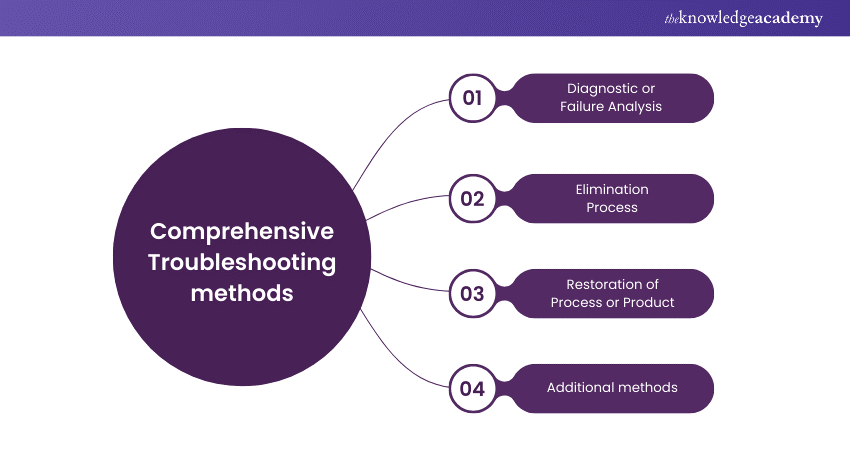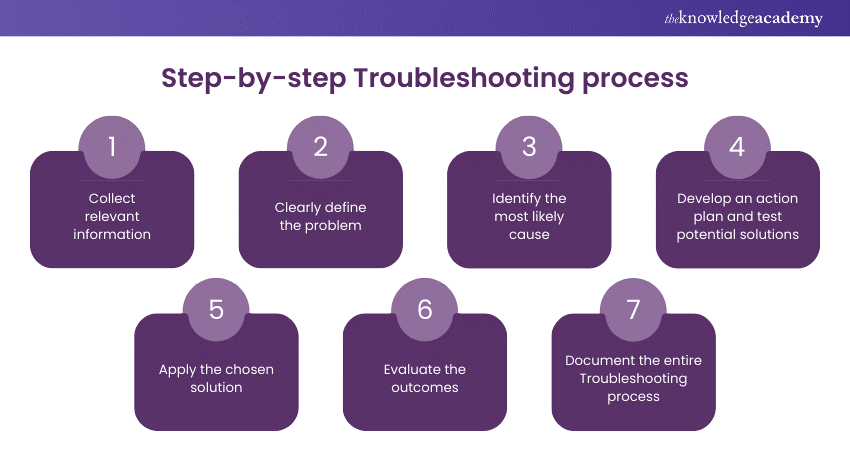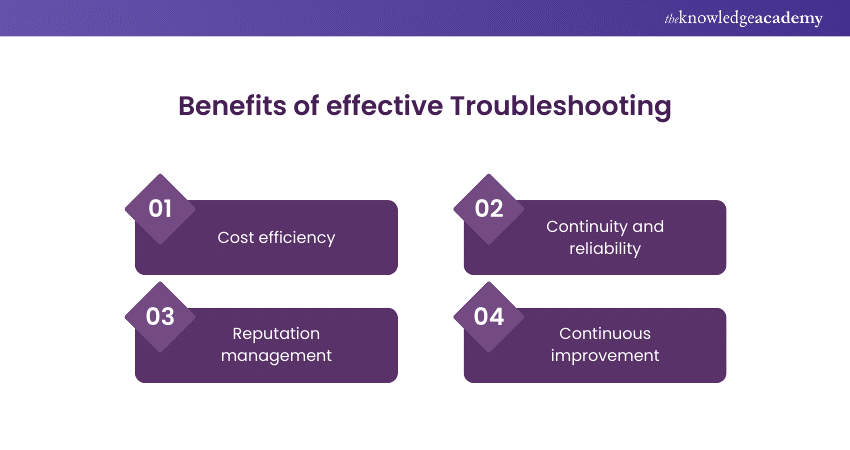We may not have the course you’re looking for. If you enquire or give us a call on 01344203999 and speak to our training experts, we may still be able to help with your training requirements.
We ensure quality, budget-alignment, and timely delivery by our expert instructors.

Troubleshooting is a critical skill and process in a myriad of fields, from information technology to customer service. At its core, Troubleshooting is about diagnosing and resolving problems, understanding why they occurred, and implementing solutions to prevent future issues. This introductory blog aims to demystify the concept of "what is Troubleshooting," presenting it not just as a technical necessity but as a fundamental approach to solving problems in our daily lives and work environments. By exploring what Troubleshooting truly entails, we can appreciate its value and how it applies to various scenarios.
The question "What is Troubleshooting?" often arises when unexpected challenges disrupt our routines or workflows. It's more than just a technical term; it's a methodical approach to identifying, understanding, and resolving issues efficiently and effectively. In this blog, we'll delve into the systematic process of Troubleshooting, uncovering its methods, benefits, and practical applications. By the end, you'll have a comprehensive understanding of what Troubleshooting is and how mastering this skill can lead to improved outcomes in both professional and personal contexts.
Table of Contents
1) Understanding Troubleshooting
2) Comprehensive Troubleshooting methods
3) Step-by-step Troubleshooting process
4) Benefits of effective Troubleshooting
5) Real-life applications and case studies of Troubleshooting
6) Advanced Troubleshooting techniques
7) Conclusion
Understanding Troubleshooting
Troubleshooting is essentially a problem-solving method, often used in diagnostic processes to identify, analyse, and resolve issues in a system, whether it be in technology, business processes, or everyday scenarios. The essence of "what is Troubleshooting" lies in its systematic approach to finding the root cause of a problem and then applying knowledge and reasoning to solve it. It's not just about fixing immediate issues but also about understanding why those issues arose in the first place and how similar problems can be prevented or mitigated in the future.
The process begins with recognising and defining the problem clearly, followed by a thorough analysis of potential causes. This is where critical thinking and experience come into play, allowing troubleshooters to hypothesise possible faults based on known symptoms. The next steps involve testing these hypotheses through experimentation or logical deduction and then implementing the most viable solution. However, "what is Troubleshooting" isn't just about the resolution; it's also about learning from the issue. If you're preparing for a job interview, reviewing Root Cause Analysis Interview Questions can help you understand how to apply this method in troubleshooting, ensuring you can identify the root causes and prevent future problems effectively. Effective troubleshooting involves documenting the problem and its solution, providing a valuable reference for preventing future occurrences, as outlined in the Windows Server Troubleshooting Guide. By understanding Troubleshooting as a structured yet flexible approach, individuals and organisations can foster a proactive mindset, reducing downtime and promoting efficiency.
Master Computer Hardware Troubleshooting and Elevate Your IT Skills – Register now!
Comprehensive Troubleshooting methods
Troubleshooting is an art as much as it is a science, requiring a blend of analytical thinking, systematic investigation, and sometimes a bit of creativity. The following methods represent different facets of this multifaceted discipline, each providing a unique approach to diagnosing and resolving problems.

Diagnostic or Failure Analysis
Diagnostic or Failure Analysis is a critical initial step in the Troubleshooting process, focusing on identifying the exact nature and origin of the problem. This method involves gathering data, reviewing system logs, or examining hardware to pinpoint where and why the failure occurred. Technicians use various tools and techniques, such as diagnostic software or physical inspections, to analyse the symptoms and trace them back to the source. By thoroughly understanding the problem's specifics, one can develop a more accurate and effective resolution strategy, making this method a cornerstone of effective Troubleshooting.
Elimination Process
The Elimination Process is a systematic method where potential causes of a problem are listed and tested one by one until the actual cause is identified. It's based on the principle of ruling out possibilities through a process of elimination. This approach is particularly useful when dealing with complex systems where multiple factors could be at play. By methodically eliminating each potential cause, troubleshooters can narrow down their focus to the real issue. Though it can be time-consuming, the elimination process ensures a thorough examination and is highly effective in isolating the root cause of a problem.
Restoration of Process or Product
Restoration of Process or Product involves returning a system or product to its original or optimal state after identifying and fixing the underlying issue. This method is not just about patching up a problem but restoring functionality and performance to ensure long-term reliability and efficiency. It may involve replacing defective components, updating software, or revising operational procedures. The goal is to not only solve the immediate problem but also strengthen the system against future issues, emphasising preventive measures and continuous improvement as integral parts of the Troubleshooting process.
Additional methods
Beyond the primary techniques, there are additional methods of Troubleshooting that cater to specific scenarios or systems. These include the Comparative Analysis method, where a functioning system is compared to a malfunctioning one to spot differences, and the Top-Down or Bottom-Up approach, where one starts from the highest or lowest point of the system hierarchy, respectively. There's also the Cause and Effect Diagram, which helps visualise the relationship between various factors and the problem. Each method has its unique advantages and can be chosen based on the problem's nature, the system's complexity, and the troubleshooter's expertise.
Discover IT Support and Solution Training Courses – Elevate your IT skills today!
Step-by-step Troubleshooting process
Troubleshooting is a systematic process that, when followed diligently, can lead to the resolution of even the most complex issues. This step-by-step guide provides a structured approach to diagnosing and resolving problems, ensuring that no stone is left unturned.

Step 1: Collect relevant information
The first step is gathering all pertinent information about the issue at hand. This includes understanding the symptoms, the environment in which the problem occurs, and any recent changes or actions that might have contributed to the issue. Accurate information is crucial for effective diagnosis.
Step 2: Clearly define the problem
Once the information is collected, the next step is to define the problem clearly. What exactly is going wrong? Be as specific as possible in describing the issue, as a well-defined problem is much easier to solve. This might also involve distinguishing between symptoms and the actual problem.
Step 3: Identify the most likely cause
With the problem clearly defined, begin hypothesising what the most likely causes could be. Based on the information gathered, use logical reasoning to deduce the most probable sources of the issue. This step might involve some trial and error, but educated guesses will guide you in the right direction.
Step 4: Develop an action plan and test potential solutions
Develop a plan to test your hypotheses. This should involve step-by-step actions to either confirm or eliminate each potential cause. Begin with the simplest and most likely solutions before moving on to the more complex ones. Each test should be controlled and its results documented. If a solution seems to resolve the issue, don't stop there. Confirm that it truly is the root cause by understanding why and how it caused the problem.
Step 5: Apply the chosen solution
Once a solution has been identified and tested, it's time to apply it. This might involve repairing, replacing, or modifying a component or process. Ensure that the solution is implemented carefully and monitor the system closely to ensure that the problem is truly resolved.
Step 6: Evaluate the outcomes
After implementing the solution, evaluate the results. Has the problem been completely resolved? Are there any unintended consequences or new issues that have arisen? This step ensures that the solution is not only effective in resolving the initial issue but also doesn't create additional problems.
Step 7: Document the entire Troubleshooting process
Finally, document every step taken during the Troubleshooting process. This includes the initial problem description, all the hypothesised causes, the tests conducted, and the final solution. Documentation is invaluable for several reasons. It helps in understanding what went wrong and how it was resolved, which is essential for preventing future occurrences. It also serves as a guide for similar issues in the future, making subsequent Troubleshooting efforts more efficient. Additionally, it contributes to a knowledge base that can be beneficial for training purposes or for other team members who might encounter similar issues.
Benefits of effective Troubleshooting
Effective Troubleshooting offers a multitude of benefits that extend beyond the immediate resolution of issues. By mastering this skill, individuals and organisations can experience significant advantages.

a) Cost efficiency: Effective Troubleshooting minimises downtime and associated losses by quickly identifying and resolving problems. This proactive approach prevents the need for more expensive solutions later, leading to significant long-term savings.
b) Continuity and reliability: Troubleshooting effectively ensures that minor problems are resolved before they impact overall performance. This maintains the flow of operations and ensures consistent delivery of services and products, which is crucial for operational reliability.
c) Reputation management: A business's ability to competently manage and resolve issues enhances its reputation. Demonstrating effective Troubleshooting skills shows commitment to quality and competence, building trust with customers and stakeholders.
d) Continuous improvement: Each resolved issue provides insights into system and process refinement. Effective Troubleshooting fosters a culture of learning and adaptation, encouraging innovation and proactive strategies for ongoing growth and improvement.
Enhance your troubleshooting skills with our macOS Mojave Troubleshooting and Support Training!
Real-life applications and case studies of Troubleshooting
Troubleshooting is a critical skill that finds application in a wide array of real-world scenarios, often preventing minor issues from escalating into major crises. Here are five illustrative examples demonstrating how effective Troubleshooting can lead to improved outcomes and efficiency:
a) Healthcare system glitch: In a hospital, a critical patient-monitoring system started giving erratic readings. Technicians used the elimination process to pinpoint the issue of a recent software update that conflicted with existing hardware. Quick Troubleshooting ensured patient safety and care continuity.
b) Automotive assembly line halt: An automotive company faced repeated halts on their assembly line. Through detailed failure analysis, they discovered a minor fault in the robotic arm's programming. Correcting this issue enhanced production efficiency and reduced unexpected downtimes.
c) Telecommunications network failure: A major telecom provider experienced a sudden network failure affecting thousands of users. Using a top-down approach, engineers quickly isolated the problem to a damaged central relay station. The rapid response restored service and maintained the provider's reputation for reliability.
d) Retail checkout errors: A retail chain encountered persistent errors in its checkout system during peak hours. Through a process of elimination, IT support traced the problem to an overloaded server. Upgrading the server capacity resolved the checkout issues, leading to improved customer satisfaction and sales.
e) School's online learning platform crash: When a school's online learning platform crashed repeatedly, IT staff used comparative analysis with a previously stable version. They found that a recent feature addition was causing the crashes. Removing the feature until a fix was available ensured uninterrupted online learning for hundreds of students.
Master the art of secure connections with our comprehensive VPN Training!
Advanced Troubleshooting techniques
Advanced Troubleshooting techniques represent the cutting-edge of problem-solving, integrating sophisticated technology and innovative methodologies to address and predict complex issues more effectively. Here are several such techniques that are transforming the landscape of Troubleshooting:
a) Predictive Troubleshooting: Utilising machine learning and artificial intelligence, this technique analyses historical data and operational patterns to predict and prevent issues before they arise, enhancing system reliability and reducing downtime.
b) Root Cause Analysis with data analytics: Advanced data analytics tools dive deep into systems to uncover the underlying causes of complex issues. This approach goes beyond treating symptoms, focusing on eradicating the source of problems for long-term solutions. However, it's important to consider the Disadvantages of Root Cause Analysis, such as the time and resources required for in-depth analysis.
c) Remote Troubleshooting tools: Modern remote troubleshooting tools, including network troubleshooting tools, enable experts to diagnose and resolve issues from afar. These tools encompass features such as remote desktop access, real-time monitoring, and advanced diagnostics, significantly reducing the need for on-site visits and speeding up the resolution process. By leveraging network troubleshooting tools, professionals can ensure more efficient and effective management of network-related issues.
d) Network Behavior Analysis (NBA): Especially useful in IT, NBA tools monitor network traffic to identify anomalies or unusual patterns. By analysing these patterns, technicians can proactively address potential security threats or performance issues.
e) Automated diagnostic systems: These systems use sophisticated algorithms to automatically diagnose and sometimes even rectify issues without human intervention. They're particularly useful in high-volume or critical environments where speed and accuracy are paramount.
Dive into the world of network storage and printing with our Samba Server Training!
Conclusion
In conclusion, effective Troubleshooting is an indispensable skill, blending analytical prowess with systematic processes to resolve issues and improve systems. Embracing both traditional and advanced techniques ensures efficient problem-solving, enhances reliability, and fosters continuous improvement, making it a critical component in the landscape of operational success.
Stuck on troubleshooting interview questions? Check out our expert tips and ace your next interview!
Frequently Asked Questions
What exactly is Troubleshooting?

Troubleshooting is a systematic approach to diagnosing and resolving problems within a system or process aimed at restoring functionality and preventing recurrence.
Why is Troubleshooting important?

Effective Troubleshooting minimises downtime, saves costs by preventing larger issues, ensures system reliability, and maintains customer satisfaction.
Can Troubleshooting be applied to non-technical issues?

Yes, Troubleshooting principles can be applied to a variety of contexts, including non-technical problems in business processes, logistics, and everyday life scenarios.
How does the Troubleshooting process begin?

Troubleshooting begins with identifying and clearly defining the problem, then gathering all relevant information about the issue and its context.
What are the other resources and offers provided by The Knowledge Academy?

The Knowledge Academy takes global learning to new heights, offering over 3,000 online courses across 490+ locations in 190+ countries. This expansive reach ensures accessibility and convenience for learners worldwide.
Alongside our diverse Online Course Catalogue, encompassing 19 major categories, we go the extra mile by providing a plethora of free educational Online Resources like News updates, Blogs, videos, webinars, and interview questions. Tailoring learning experiences further, professionals can maximise value with customisable Course Bundles of TKA.
What is Knowledge Pass, and how does it work?

The Knowledge Academy's Knowledge Pass, a flexible prepaid voucher system, offers the freedom to enrol in courses over a 12-month period. Start your limitless learning adventure with us and embrace education that knows no bounds.
What are related courses and blogs provided by The Knowledge Academy?

Discover an array of IT Support and Solution Training Courses at The Knowledge Academy, featuring specialised training in MacOS Mojave Troubleshooting and Support, VPN, and Samba Server. Designed for different skill levels, our courses provide the necessary technical expertise to meet business IT needs.
Whether you're starting out or looking to upgrade your skills, immerse yourself in our IT Support and Solution blogs for further understanding and expertise. Embark on a journey with us to elevate your IT Support and Solution proficiency!
Upcoming IT Infrastructure & Networking Resources Batches & Dates
Date
 Computer Hardware Troubleshooting Course
Computer Hardware Troubleshooting Course
Fri 2nd May 2025
Fri 4th Jul 2025
Fri 5th Sep 2025
Fri 7th Nov 2025






 Top Rated Course
Top Rated Course



 If you wish to make any changes to your course, please
If you wish to make any changes to your course, please


